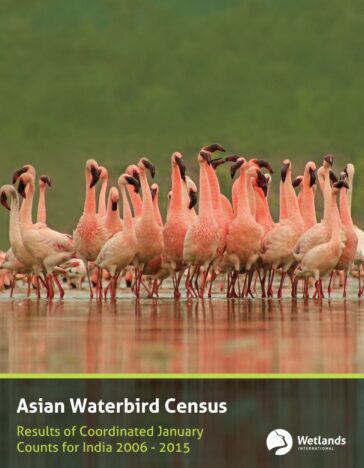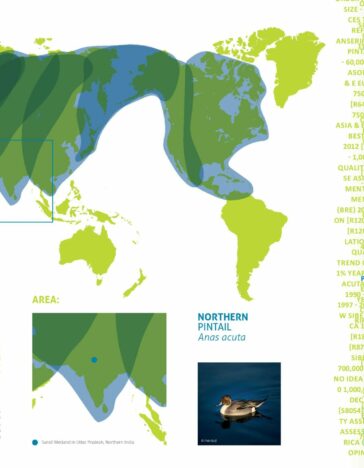
Convention on Migratory Species conference adopts ‘ecological connectivity’ declaration
-
Asian Waterbird Census
-
International Waterbird Census
The Convention on Migratory Species (CMS CoP13) conference in February concluded with significant decisions, including a declaration on ecological connectivity that reiterates the importance of maintaining functional networks of sites and habitats to help reverse biodiversity loss and strengthen the management of their habitats worldwide.
Waterbirds are an essential component of wetland landscapes. Their presence, numbers and trends at a site can tell us a lot about the health and quality of a wetland. Yet a report presented at CMS CoP13 shows that most populations of migratory species covered by CMS are declining despite global efforts.
To halt the decline of these animals, particular attention needs to be paid to developing and implementing policies to protect wetlands and other habitats across the migratory routes. Ecological connectivity provides a necessary framework to manage ecosystems for the benefit of migratory and resident species as well as humans dependent on these ecosystems.
Wetlands International supports ecological connectivity through working closely with governments, conventions, NGO and technical experts to develop tools and programmes that protect and manage internationally important wetlands and monitor the effectiveness of species conservation plans.
Taking action to protect migratory species
CMS CoP13 adopted the Gandhinagar Declaration, which calls for migratory species and the concept of ‘ecological connectivity’ to feature in the Post-2020 Biodiversity Framework. The theme of ecological connectivity is recognised as a high priority for the CMS, especially as the Post-2020 Biodiversity Framework is being finalised and should be agreed by all governments at the Convention on Biodiversity Conference of Parties later this year.
Taking steps to protect migratory species and their habitats will require effort at intergovernmental levels by working with biodiversity and climate conventions and the national level, including a wide range of plans such as National Biodiversity Strategies and Action Plans (NBSAPs) and by mainstreaming these into other development planning, climate change adaptation and mitigation frameworks.
At CoP13, Parties adopted several essential resolutions and time-bound decisions that commit governments to implement a range of actions nationally and collaborate internationally to conserve migratory waterbirds, other birds and their habitats over the next three years. This includes dealing with significant barriers and threats to these birds, such as improving planning and implementation of more comprehensive impact assessments in development and routing of power lines, highways, railways, pipelines and renewable energy infrastructure, as well as reducing poisoning, illegal killing and habitat loss.
The government of India has pledged to work with governments develop an international mechanism to promote conservation of migratory birds and their habitats in the Central Asian Flyway, a flyway region long challenged with rapid species declines and habitat loss.
Wetlands International has been leading efforts with governments, conventions & partners to develop and implement flyway-wide conservation frameworks and actions here over the last two decades.
CMS CoP13 also saw ten migratory species added to CMS Appendices and adopted Concerted Actions with targeted conservation plans for 14 species, including the Indian Skimmer, listed as Vulnerable on the IUCN Red List of Threatened Animals. For the full list, please click. The CoP also agreed on several cross-cutting policy measures to address threats to migratory species:
- Integration of biodiversity and migratory species considerations into national energy and climate policy and to promote wildlife-friendly renewable energy;
- Strengthen initiatives to combat the illegal killing, taking and trade of migratory birds;
- Mitigate the impacts of linear infrastructure such as roads and railways on migratory species;
- Address the unsustainable use of aquatic wild meat (including waterbirds);
- Undertake a review of by-catch levels of sharks and rays, and further implement by-catch mitigation measures for marine mammals in national fishing operations;
- Deepen our understanding of the importance of animal culture and social complexity for the conservation of endangered species;
- To investigate possible trade-in CMS Appendix I species and the implications for their conservation status.

Safeguarding connectivity: from bird data to management tools
During our side event, “Safeguarding connectivity: from bird data to management tools” we launched the latest report from the Asian Waterbird Census in India with the Ministry of the Environment, Forests and Climate Change. The results from this census are crucial to ongoing biodiversity negotiations throughout this year because it highlights vital data on the status of waterbirds and wetlands that will inform action plans and wetlands of international importance.
Dr Taej Mundkur, senior technical officer, Wetlands International, discussed various steps from collecting the waterbird data to applying the results for conservation and management and the development of a new interactive Waterbird Populations Web Portal, with support from the Environment Agency of Abu Dhabi. Dr Mundkur said:
“We foresee this new waterbird web portal will make, in a very user-friendly way, critical up-to-date information far more accessible to wetland managers and other users, including population estimates, trends and 1% levels which is necessary for designation of internationally important wetlands.”
To complement the sharing of information on waterbirds, the Critical Site Network (CSN) tool, which was developed by Wetlands International and BirdLife International, was also highlighted at our side event.



